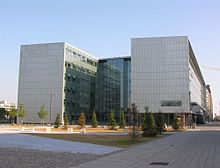IT University of Copenhagen
| IT University of Copenhagen | |
|---|---|
|
|
|
| founding | 1999 |
| place | Copenhagen |
| country | Denmark |
| management | Martin Zachariasen |
| Students | 2,419 (2017) |
| Employee | 333 full-time equivalents (2017) |
| including professors | 77 |
| Annual budget | 276 million Danish kroner (2017) |
| Website | www.itu.dk |
The IT University of Copenhagen is a Danish independent university.
The foundation took place in 1999. With the entry into force of the Danish University Act of 2003, the institution became a university, the twelfth and smallest in Denmark, and the name was changed to IT-Universität Copenhagen - 'The IT University of Copenhagen' in English.
In 2004 the university moved into its new building in the Ørestad district of Copenhagen, right next to the humanistic faculty of Copenhagen University and the new main building of the Danish radio and television company DR. The new building was designed by the Danish architect Henning Larsen .
Initially, the university only offered master’s courses that required a bachelor’s degree. In August 2007, a bachelor's degree in software development was offered for the first time. Every semester since 2010, the IT University has been running three bachelor’s degree programs (one of which is globally oriented in English), four master’s degree (including two globally oriented in English), four professional master’s degree programs, a diploma program and around 100 individual subjects.
The IT university, which has only one faculty, deals with the interdisciplinary study of computer science and chooses a wide variety of approaches: natural sciences (traditional computer science), software development, computer-aided cooperation, design and use of IT, e-business, computer game studies as well as social, cultural and aesthetic aspects of computer science.
In addition to the 40 academic staff, the university has 50 Ph.D. students and more than 2000 students.
Administration and organization
The university is managed by an advisory board consisting of nine members: the five members of the advisory board recruited outside the university represent the majority, one member is elected by the academic staff and one by the university's technical and administrative staff, while two members are elected by the students to get voted. The rector is elected by the advisory board.
Course offer
Bachelor courses (BSc in IT) :
- Global Business Informatics (EN)
- Digital media and design (DÄ)
- Software development (DÄ)
Master of Science programs (MSc in IT)
- Games (EN)
- Software Development and Technology (EN)
- Digital design and digital communication (DÄ)
- Digital Innovation & Management (e-Business)
Diploma in IT
The diploma program enables individual subjects to be compiled into a personal training package.
Professional Master's Degree Programs (Master of IT)
- IT management (DÄ)
- Interaction design (DÄ)
- Software construction (DÄ)
The IT university offers more than 100 individual courses.
research
The declared aim of university research is to promote the IT-based added value in Denmark. Research results should form the basis for new types of interaction, new breakthroughs in digital culture, better resource optimization and technological innovations.
See also
Web links
Individual evidence
- ↑ Press release. Retrieved August 8, 2019 .
- ↑ Annual Report 2017 (English), p. 18 (PDF)
- ↑ Annual Report 2017 (English), p. 18 (PDF)
- ↑ Annual Report 2017 (English), p. 14
Coordinates: 55 ° 39 ′ 36.8 " N , 12 ° 35 ′ 27.7" E

